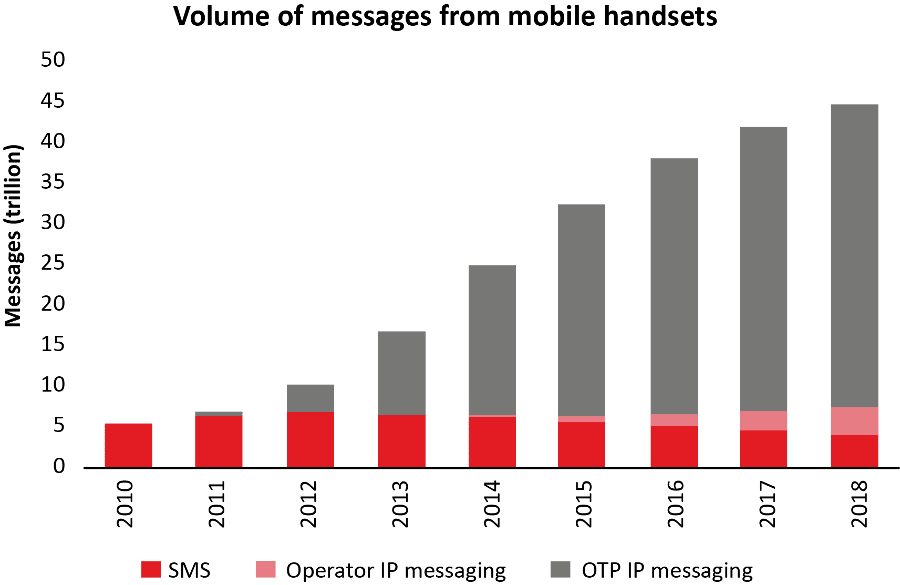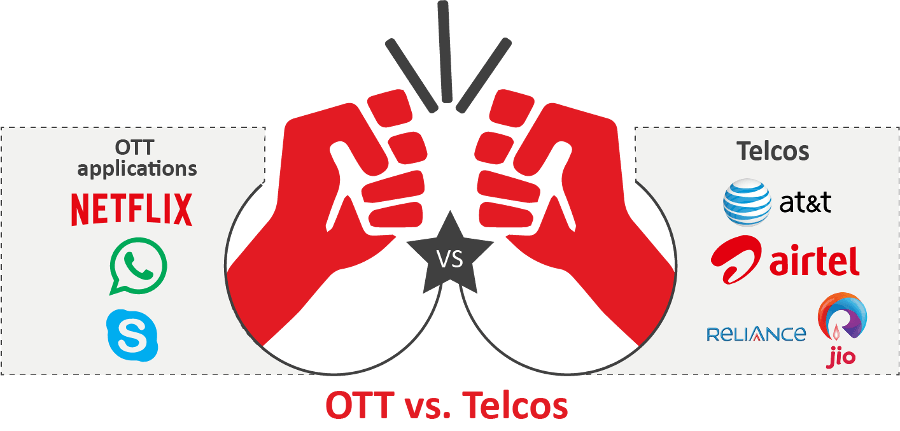Most of us are using Over-The-Top (OTT) services without realizing. Simply put, OTT is a service used via internet through the ISPs. For instance, users avail Skype or WhatsApp to make cheaper calls and send messages through the 3G network and Wi-Fi. This eats into the revenues of telcos the sector won’t change as long as net neutrality exists. Additionally, content platforms such as Netflix, Saavn, and Hulu have also gained traction as OTT applications.
The communication industry has undergone a significant transformation in the last decade. Today’s subscribers consume more multimedia content than ever before. This trend will continue in the future with the increasing dominance of OTT services. Such third party OTT communication services are preferred more than the legacy services offered by telcos. Traditionally, voice and messaging (SMS) have been the principal revenue streams of telecom carriers. Consequently, telecom carriers see OTT service providers posing a challenge to their revenues streams.
Potential of OTT
Today, all internet connected devices are capable of installing OTT applications. OTT services have come a long way. What started off as a minimal calling application a decade ago has emerged as a multi-communication channel. The rapid evolution of OTT applications is backed by a flourishing startup ecosystem and scalable innovation. Pioneering developers are striving to integrate innovative features.
The promises made by tech giants over the years have started translating into reality. The evolution of futuristic OTT applications is reflecting in emerging business models, platform & app diffusion, and consumer behavior.

Impact of OTT Disruption on CSPs
With a rise in mobile devices and increasing internet speed, users can exercise the option to consume digital content ‘anytime-anywhere’. The internet continues to be the disruptive force for bridging the gap between digital content and devices. Since the dawn of modern communication facilities, OTT applications have outpaced legacy telecommunication services. Additionally, app-based communication is shrinking the revenues of telecom operators.

With consumers having a penchant for OTT services, the key players of the telecommunication industry are facing a dual challenge. Firstly, telcos are struggling to power a digital world with a fast, reliable and secure network. Secondly, telcos need to meet the rising customer demands of on-demand content.
The telecom operators are yet to adapt to the transformative forces of OTT, which are highly disruptive. IDC Saudi Arabia’s senior research analyst – telecoms & digital media, Tolga Yalcin, said the emergence of OTT has dented the messaging revenues of telecom carriers. “We have seen the primary impact of OTT players on telcos’ messaging revenues with the high-level substitution of national and international SMS services with instant messaging (IM) applications like Whatsapp and iMessage. In 2015, SMS/MMS revenues decreased by 2% in Saudi Arabia and 5% in UAE and we expect this trend to continue at an accelerating rate.”
According to global TMT research firm Ovum, the Middle Eastern subscription is set to grow dramatically compared to other regional markets over the next few years. The video-on-demand revenues will grow by over 25% annually by 2019, accounting for over 70% of OTT revenues. It is difficult to quantify the market share captured by OTT. Though, its impact on traditional services such as voice and messaging is significant. It is pertinent to mention that OTT applications have also captured the youth segment that prefers social media over traditional communication methods.
OTT Services: Opportunity for Telcos
Disruptive OTT services may pose a threat to the telecommunication industry, but it is also throwing up promising opportunities. The opportunity lies in the convergence between telcos and information technology OTT applications. It also indicates the harmonious coexistence of both network providers and content platforms in the digital ecosystem.
But very few telecom carriers are able to solve the challenge of monetization. However, solving the dual challenge presents a dual opportunity to telcos – improved customer experience and operational advantage.

Bold decision #1 – partnering the foe
Firstly, the customer dialogue can’t be defensive for telecom carriers. Hence, operators need to shift their focus to boosting customer satisfaction. Proactive telecom service providers are able to identify the demanding consumer behavior for on-demand OTT services. Such operators have started collaborating with the key players in the OTT industry. Airtel entered into a partnership with Facebook, while Reliance also collaborated with WhatsApp. Such strategic partnerships help telcos understand customer behavior and reduce churn. Additionally, telecommunication operators can predict and react to their consumer needs in real time with market intelligence data.
Bold decision #2 – making new friends
Secondly, interactive content platforms can bring operational efficiency to telecom carriers with competitive margins. Clearly, partnering with successful content platforms can help telcos reap significant revenues from OTT services. Revenue models like AVOD (Advertising Video on Demand) and SVOD (Subscription Video on Demand) can help telcos see value from their outlay. For carriers looking forward to developing content platforms – in-app purchases, streaming broadcast media on mobile devices, and complementing adverts with secondary adverts are some of the proven revenue models. With the huge technological shift, this can be a commercial reality for telcos.
By using advanced metadata from content platforms, telcos can better target content and drive customer satisfaction to a greater extent. For an instance Reliance Jio, a network operator in India, is making inroads in the league of OTT applications. Also, Verizon has opened doors for carriers to unlock the revenue potential of carrier data. With Verizon ‘Exponent’, customer experience takes the front seat with media services platform, big data and AI, IoT, internet services, and cloud platforms.
Is there another way for telcos to respond to OTT applications?
Another way for telcos to respond to the Mobile Instant Messaging (MIM) transition of OTT is to create a global standard operator-owned messaging service. Such a step needs a hybrid approach of integrating multimedia features like audio-video content support, and group messaging functionality. To capture a share of MIM revenues, telecom service providers need to adopt a strategy of being an all-inclusive content platform.
As telcos try to tap the potential of digital services, it is imperative for them to identify their assets, differentiators, and adopt strategies for the digital ecosystem. To defend the status of being a network gatekeeper, telecom service providers must also focus on OTT services for interactive content. Capping data usage to access certain interactive content applications can help intensify OTT initiatives. For instance, StarHub of Singapore tied up with famous OTT application WeChat to offer unlimited access to its prepaid subscribers at a minimal cost.
Can the telecom sector afford to lag behind?
Telcos can power a completely new breed of content platforms. However, a major challenge for telecom carriers is to create a roadmap for disruption. Industry leaders are also perplexed about their organizational flexibility undermining their business models to get the most out of the disruptive technology such as OTT. The entrepreneurial vision, capex requirements and operational complexities of telecom providers are significant factors that should be taken into account while venturing into digital communication services. For telcos to maintain steady growth, it is important to focus on OTT services with a strategic perspective.
The digital communication platform remains an open space for telecom providers to innovate with the right business model, and position themselves as brands of future. Indeed, the telecommunication sector has overcome formidable barriers in the past. With the right strategic outlook, telecom carriers can ride the wave of the OTT success frenzy, and reap incremental value in terms of the consumer base and revenue streams.









